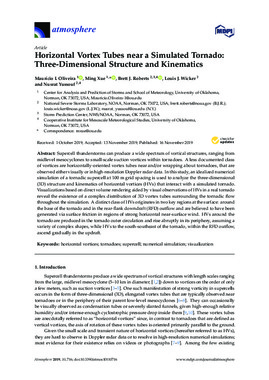| dc.contributor.author | Oliveira, Mauricio I. | |
| dc.contributor.author | Xue, Ming | |
| dc.contributor.author | Roberts, Brett J. | |
| dc.contributor.author | Wicker, Louis J. | |
| dc.contributor.author | Yussouf, Nusrat | |
| dc.date.accessioned | 2020-02-18T16:23:27Z | |
| dc.date.available | 2020-02-18T16:23:27Z | |
| dc.date.issued | 2019-11-16 | |
| dc.identifier.citation | Oliveira, Maurício I.; Xue, Ming; Roberts, Brett J.; Wicker, Louis J.; Yussouf, Nusrat. 2019. "Horizontal Vortex Tubes near a Simulated Tornado: Three-Dimensional Structure and Kinematics." Atmosphere 10, no. 11: 716. | en_US |
| dc.identifier.uri | https://hdl.handle.net/11244/323758 | |
| dc.description.abstract | Supercell thunderstorms can produce a wide spectrum of vortical structures, ranging from midlevel mesocyclones to small-scale suction vortices within tornadoes. A less documented class of vortices are horizontally-oriented vortex tubes near and/or wrapping about tornadoes, that are observed either visually or in high-resolution Doppler radar data. In this study, an idealized numerical simulation of a tornadic supercell at 100 m grid spacing is used to analyze the three-dimensional (3D) structure and kinematics of horizontal vortices (HVs) that interact with a simulated tornado. Visualizations based on direct volume rendering aided by visual observations of HVs in a real tornado reveal the existence of a complex distribution of 3D vortex tubes surrounding the tornadic flow throughout the simulation. A distinct class of HVs originates in two key regions at the surface: around the base of the tornado and in the rear-flank downdraft (RFD) outflow and are believed to have been generated via surface friction in regions of strong horizontal near-surface wind. HVs around the tornado are produced in the tornado outer circulation and rise abruptly in its periphery, assuming a variety of complex shapes, while HVs to the south-southeast of the tornado, within the RFD outflow, ascend gradually in the updraft. | en_US |
| dc.description.sponsorship | The first author is supported by the Coordenação de Aperfeiçoamento de Pessoal de Nível Superior (CAPES), Grant number 88881.129505/2016-01 of the “Programa de Doutorado Pleno no Exterior” (DPE – 3830) under the Brazilian Ministry of Education. The second author is supported NSF Grant AGS-1261776 and NOAA VORTEX-SE Grant NA17OAR4590188. Open Access fees paid for in whole or in part by the University of Oklahoma Libraries. | en_US |
| dc.language | en_US | en_US |
| dc.rights | Attribution 4.0 International | * |
| dc.rights.uri | https://creativecommons.org/licenses/by/4.0/ | * |
| dc.subject | horizontal vortices | en_US |
| dc.subject | tornadoes | en_US |
| dc.subject | supercell | en_US |
| dc.subject | numerical simulation | en_US |
| dc.subject | visualization | en_US |
| dc.title | Horizontal Vortex Tubes near a Simulated Tornado: Three-Dimensional Structure and Kinematics | en_US |
| dc.type | Article | en_US |
| dc.description.peerreview | Yes | en_US |
| dc.identifier.doi | 10.3390/atmos10110716 | en_US |
| ou.group | College of Atmospheric and Geographic Sciences::School of Meteorology | en_US |

